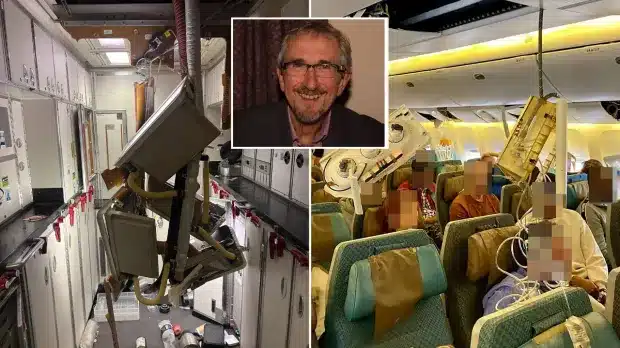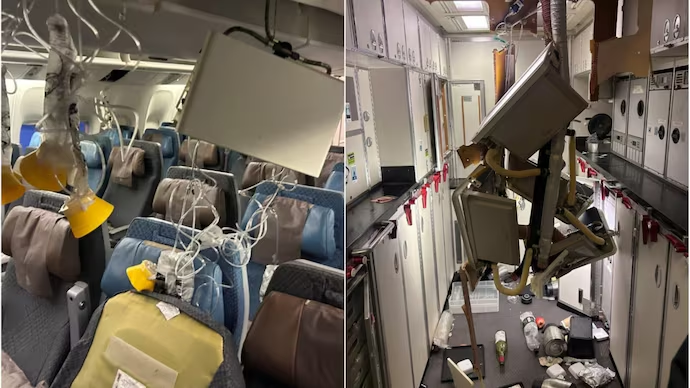News
Singapore Airlines Passenger Killed During Severe Turbulence
London-Singapore Airlines crashed into an air pocket during breakfast, according to Bangkok Suvarnabhumi airport general manager Kittipong Kittikachorn. The pilot requested an emergency landing.
The aircraft reported sudden turbulence above Myanmar’s Irrawaddy Basin eleven hours into the flight. Without further details, the statement said the pilot reported a medical issue and rerouted the jet to Bangkok.
Reuters could not determine whether the medical issue preceded the turbulence.
Massive gashes in the overhead cabin panels, gas masks and ceiling panels, and scattered hand luggage were seen inside the airplane. Multiple heads punctured the panels above the lights, according to a passenger.
“I saw things lying everywhere and many air crew members injured” after the most severely injured passengers and crew were evacuated.
Kittikachorn believes the 73-year-old British man who died suffered a heart attack. Seven people were seriously injured, including brain trauma. He stated everyone seemed calm when they were led off the plane.

Passengers were having breakfast when the turbulence struck: Reuters Image
Singapore Airlines condolences to the family
The Singapore Airlines apologized for the disturbing experience passengers and crew experienced on this journey.
Injury rates varied among the 211 passengers and 18 crew members. The airline reported 12 hospitalized and 18 admitted passengers. At Samitivej Hospital, 71 patients were being treated.
First, publicly available tracking data could not reconstruct the incident. However, FlightRadar 24 said it was studying data from 07:49 GMT that showed the plane leaning upwards and returning to its cruise altitude in less than a minute.
Reuters claimed that a Boeing 777-300ER passenger described feeling like you were rising and then plummeting.
As reported by Reuters, 28-year-old student Dzafran Azmir said, “Suddenly the aircraft starts tilting up and there is shaking, so I braced for what is about to happen, but suddenly there is a dramatic drop, causing everyone sitting without a seatbelt to be launched into the ceiling..”
According to him, some people hit their heads on the baggage cabins overhead and dented them. They also hit the areas where the lighting and masks are and used their heads to break straight through them.
The majority of passengers Kittikachorn spoke with said all the Singapore Air passengers were wearing seatbelts at the time of the accident.
According to a report posted by FlightRadar 24 about the altitude drop, “our initial thinking is that the turbulence event occurred before the standard descent from 37,000 to 31,000 feet.” They’re probably altering the flying levels before landing.”
It has been reported by the Suvarnabhumi airport that the plane requested an emergency landing at 3:35 p.m. Bangkok time (8:35 GMT) at the time of the incident. In the meantime, uninjured passengers were able to board a different flight at 3:51 pm.
An investigation will be conducted in Bangkok by Singapore’s Transport Safety Investigation Bureau (TSIB).

Aftermath of Singapore Airlines turbulence: Reuters Image
Flight Air Turbulence
The U.S. National Transportation Safety Board found that turbulent circumstances cause the most airline crashes in 2021.
Turbulence caused over 33% of airline accidents between 2009 and 2018, with most resulting in serious casualties but little aircraft damage, according to the U.S. government. NTSB representatives will assist Singapore Airlines incident investigation, the statement said.
Singapore Airlines, a premium airline that sets the benchmark for the industry, has had few major issues in recent years.
The final fatal accident occurred on October 31, 2000, when it crashed into construction equipment at Taiwan Taoyuan International Airport after taking off from the wrong runway from Singapore to Los Angeles via Taipei. The crash killed 83 of 179 people.
The Aviation Safety Network lists seven Singapore Airlines accidents.
Boeing said it was in touch with Singapore Airlines and ready to help. Additional queries were sent to the airline and area police.































